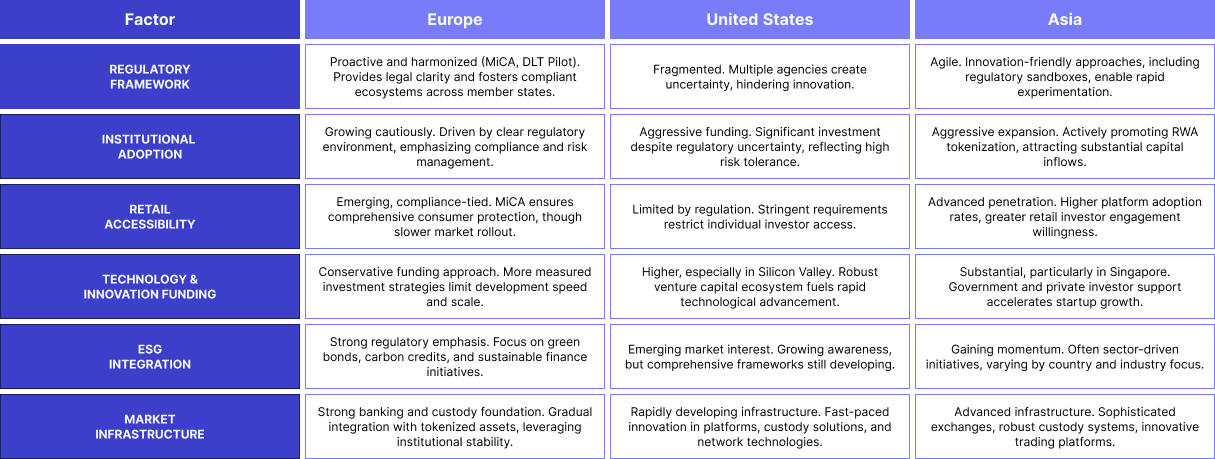Europe's Strategic Path to Digital Asset Tokenization
A Global Blueprint for Responsible Innovation: Europe aims to lead tokenization through structured regulation and compliance-first approach.

A Global Blueprint for Responsible Innovation: Europe aims to lead tokenization through structured regulation and compliance-first approach.
This analysis was prepared by Yooro's team to help our clients understand the evolving tokenization landscape and identify strategic opportunities in Europe's regulated digital asset ecosystem. Discover how MiCA and DLT frameworks position Europe as the global digital asset leader.
The digital asset tokenization market is experiencing unprecedented growth worldwide. The global tokenization market was worth USD 70 billion in 2024 and is estimated to reach ca USD 2 trillion by 2030, growing at a CAGR of 75%[1]. This explosive growth is driven by increasing demand for secure digital payment solutions, expanding blockchain applications beyond cryptocurrencies, and surging institutional interest in real-world asset (RWA) tokenization.
Leading Asian economies like Singapore and Hong Kong are pioneering regulatory sandboxes and providing clear guidelines to attract tokenization innovators. Meanwhile, the United States leads in venture funding and infrastructure development but struggles with regulatory fragmentation that hampers widespread adoption.
The global tokenization surge stems from interconnected factors beyond secure digital payments. Blockchain technology is expanding into diverse sectors including supply chain management, intellectual property protection, and healthcare innovation. Institutional interest in Real-World Asset tokenization is particularly significant, as it bridges traditional finance with distributed ledger technology, offering enhanced liquidity and fractional ownership for previously illiquid assets like real estate, private equity, and fine art.
Major financial institutions and investment firms are increasingly leveraging blockchain technology for operational efficiency and new investment opportunities. While the U.S. dominates venture capital and technological infrastructure, its fragmented regulatory landscape creates adoption challenges. In contrast, Asian financial centers actively foster innovation through regulatory sandboxes and clear guidelines, positioning themselves as tokenized securities market leaders. Progressive regions like the UAE and Switzerland are also developing forward-thinking regulatory frameworks to attract blockchain and tokenization businesses, creating a competitive global environment for digital asset innovation.
In 2024, Siemens issued a EUR 60 million digital bond using public blockchain infrastructure, marking one of the first fully regulated tokenized debt instruments by a major European corporation. The bond was issued under Germany’s Electronic Securities Act (eWpG) without needing a traditional central securities depository.
This live deployment demonstrated that large corporations can now bypass intermediaries, reduce settlement friction, and deliver programmable financial instruments under existing EU frameworks — a milestone for enterprise-grade tokenization in Europe (Siemens Press Release, Feb 2023).
“With our innovative products and technologies, Siemens supports the digital transformation of its customers. That’s why we are also actively driving forward the development of digital solutions in the financial sector.” — Peter Rathgeb, Corporate Treasurer, Siemens AG
The World Bank emphasizes the importance of financial inclusion and technological modernization, particularly in Eastern and Southern European member states[2]. Tokenization's ability to fractionalize assets and reduce market entry barriers increasingly positions it as a tool for democratizing capital market access for retail and underserved investor groups.
Europe faces several implementation hurdles:
These challenges are counterbalanced by significant European strengths:
In 2021, the European Investment Bank (EIB) issued a EUR 100 million digital bond on Ethereum in collaboration with Banque de France, Société Générale, and Goldman Sachs. The issuance was settled using a central bank digital currency (CBDC) developed by Banque de France, making it one of the first fully on-chain sovereign-grade debt instruments.
This pilot proved that tokenization can align with both ESG objectives and central bank oversight, while streamlining issuance and settlement through public blockchain rails. (EIB, April 2021)
“The EIB believes that blockchain can bring added value to market participants through reduced costs, improved efficiency and transparency, and faster settlement.” — European Investment Bank
Europe's tokenization approach is defined by two groundbreaking regulatory initiatives:
MiCA provides a harmonized framework for crypto-assets, covering everything from stablecoins to utility tokens. It ensures consumer protection and market integrity across all EU member states, creating legal certainty for digital asset businesses.
This framework allows temporary operation of DLT market infrastructures trading tokenized securities, providing a controlled innovation environment before full regulatory integration. These frameworks collectively create level playing fields and foster cross-border interoperability, making Europe an attractive jurisdiction for tokenization projects seeking legal certainty and market access.
In 2023, UBS launched the world’s first digital bond that is publicly listed, traded, and settled on both blockchain and traditional infrastructure. The CHF 375 million bond was issued on the SIX Digital Exchange (SDX) and settled via dual infrastructure—giving institutional investors access through either the blockchain or existing settlement systems like Euroclear.
The issuance was fully compliant with Swiss law and was hailed as a milestone for merging legacy systems with distributed ledger technology. It also demonstrated how tokenized instruments can seamlessly coexist within traditional capital markets—without requiring parallel infrastructure.(UBS, 2022)
“This shows that the tokenization of financial assets is now a reality and ready to be deployed at scale.” — Beatriz Martin, Group Treasurer, UBS
Despite its robust regulatory environment, Europe must navigate implementation complexities. EU directive interpretation varies across member states, creating operational challenges for cross-border businesses. Traditional European financial institution conservatism means blockchain infrastructure adoption often lags behind more agile markets. Lower venture capital activity compared to the U.S. can limit innovative tokenization startup growth.
However, Europe's strong ESG principles present unique opportunities. Tokenization offers a new model of digital asset ownership that enhances transparency, efficiency and accessibility[3]. Tokenization facilitates transparent and efficient ESG-compliant asset tracking, including green bonds and carbon credits, aligning with the region's broader sustainability objectives.
In 2023, HSBC and the Hong Kong Monetary Authority (HKMA) piloted a tokenized green bond as part of Project Evergreen—a landmark issuance designed to test digital asset infrastructure and ESG traceability in tandem. The HKD 800 million bond was tokenized on GS DAP, a blockchain platform developed by Goldman Sachs, with HSBC acting as arranger and investor. Real-time tracking of green performance indicators and automated compliance with ESG criteria were embedded directly into the smart contracts.
The project marked an important step in demonstrating how tokenization can improve transparency, accountability, and efficiency in sustainable finance.(HSBC, 2023)
“Tokenization has the potential to improve efficiency in the bond issuance process and enhance transparency.”
— HSBC, 2023

While other regions move faster in experimentation and market rollout, Europe’s compliance-first approach offers a more durable blueprint—grounded in trust, interoperability, and regulatory clarity essential for long-term capital formation and market stability.
As the World Economic Forum emphasizes, tokenization can allow almost any real world asset to have a digital representation on a blockchain, but this technological shift represents a significant governance challenge[4]. Europe's competitive advantage lies in building cross-border and institutional trust, ensuring tokenization isn't just fast, but fair, inclusive, and future-proof.
The tokenization trajectory suggests a future where digital assets play increasingly central roles in global finance. For Europe, the strategic focus will likely remain on refining regulatory frameworks to adapt to technological advancements and market demands, while fostering greater member state collaboration to ensure seamless cross-border operations. The emphasis on trust and regulatory legitimacy could attract traditional financial institutions seeking secure, compliant pathways into the digital asset ecosystem.
One clear example of this compliance-first leadership model is Société Générale – FORGE, which has issued multiple blockchain-native instruments in recent years. In 2021, it launched a EUR 5 million structured note fully registered on the Tezos public blockchain, and in 2023 followed with a EUR 10 million digital green bond issued on Ethereum. These instruments were not only programmable and fully settled on-chain but also admitted to the Luxembourg Stock Exchange, demonstrating their legal compatibility with existing financial market infrastructure.
The initiative illustrates how traditional banks can harness public blockchains within regulated environments to deliver secure, transparent, and ESG-aligned financial products. (Societe Generale, 2021)
“This transaction is a new illustration of the innovative services developed by Societe Générale on digital instruments... enabling increased efficiency and fluidity in financial transactions.” — Société Générale – FORGE
Globally, RWA tokenization trends are expected to accelerate, driven by potential for increased liquidity, fractional ownership capabilities, and reduced transaction costs. The dynamic interplay between regulatory innovation, technological development, and institutional adoption will shape tokenization's future landscape, making it a critical area for economic growth and financial evolution.
Europe's measured approach to digital asset innovation positions it uniquely in the global tokenization ecosystem. By prioritizing regulatory clarity, consumer protection, and cross-border collaboration, European markets are creating sustainable foundations for long-term digital asset adoption.
Yooro is the operating system for private capital markets: a full-stack platform to raise, manage, and deploy capital across private markets – built to remove reg, tech and ops complexity.
Our mission is to empower the transformation of private capital markets by delivering seamless, compliant, and intelligent infrastructure that removes friction, unlocks access, and fuels long-term value creation.
Ready to talk? Start a conversation with our team by clicking on the chat bubble—let’s explore how we can help you simplify compliance, boost efficiency, and unlock new opportunities.